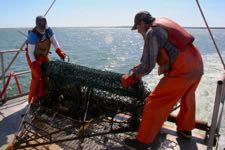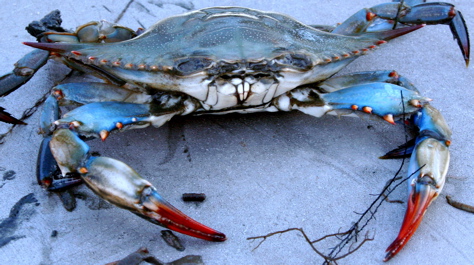Scientific survey shows highest-ever level of spawning-age female crabs
The Virginia Marine Resources Commission today released the results of the 2017 Blue Crab Winter Dredge Survey, which shows a 31% increase in adult female crabs and forecasts another year of improved harvests. This is the highest level of adult, spawning-age females recorded in the survey's 28-year history.
Conducted annually by the Virginia Insitute of Marine Science and the Maryland Department of Natural Resources since 1990, the winter dredge survey is the primary assessment of Chesapeake Bay’s blue crab population. Survey scientists employ crab dredges to sample blue crabs at 1,500 sites throughout the Bay from December through March. By sampling during winter when blue crabs are buried in the mud and stationary, the scientists can estimate, with good precision, the number of crabs present.
 In releasing VMRC's interpretation of this year's survey results, Commissioner John M.R. Bull says, “The big picture is the stock overall is in pretty good shape. This year’s harvest should be substantial and consumers should find plenty of tasty crabs for the dinner table. Challenges remain, however, and we need to remain vigilant and cautious in our management of this ecologically and economically important stock.”
In releasing VMRC's interpretation of this year's survey results, Commissioner John M.R. Bull says, “The big picture is the stock overall is in pretty good shape. This year’s harvest should be substantial and consumers should find plenty of tasty crabs for the dinner table. Challenges remain, however, and we need to remain vigilant and cautious in our management of this ecologically and economically important stock.”
VIMS professor Rom Lipcius, who oversees Virginia's portion of the Blue Crab Winter Dredge Survey, says "The total population is solid, such that we expect an ample harvest. The female spawning stock is above the stock-assessment target, which promises good recruitment of young crabs in the future, despite low recruitment this year." He notes that an integrated advisory report combining data from the winter dredge survey and several other blue crab surveys at VIMS and other scientific institutions will be released in May.
2017 Winter Dredge Survey Results
The results of the 2017 winter dredge survey show the total population of blue crabs in Chesapeake Bay fell a bit, by 18%, due to a decline in the number of juvenile crabs, but remains at the 11th-highest level ever recorded.
This year’s female spawning stock increased by 31%, from 194 million to 254 million crabs, which surpassed the scientifically recommended target of 215 million spawning female crabs and remains well above the minimum safe threshold of 70 million crabs. Spawning age female crabs are the cornerstone to maintaining a vibrant crab stock, and depend on conservative and cooperative fishery management efforts among the Bay jurisdictions.
The adult male stock fell by 16%, from 91 million to a still-substantial 76 million.
However, the juvenile abundance plummeted by 54%, from 271 million to 125 million, which is the fourth-lowest level on record. This was unfortunate but not unprecedented, as optimal spawning conditions do not occur every year. Crab spawning naturally fluctuates and can be affected by wind, currents, storms, temperature, and cannibalism. In recent years, predation events and environmental factors have caused at times dramatic downturns in crab-stock abundance. For example, the level of juveniles fell from 581 million in 2012 to a mere 111 million in 2013.
Adaptive Management
The reproductive variability of blue crabs highlights the need for fishery managers to continue to enhance resilience of the stock through adaptive management to compensate for unusual or extreme environmental conditions and the resulting impacts on reproductive success.
"Just three years ago, the number of adult female crabs was so low that a harvest cut was necessary to help rebuild them," says Bull. "We are out of that danger zone, due to adaptive and effective management of this fishery. The spawning stock is in solid shape but more work needs to be done."
VMRC, Maryland, and the Potomac River Fisheries Commission enacted a baywide 10% crab harvest reduction in 2014 to combat low overall crab abundance and to boost a dangerously depleted female spawning stock.
Bay fishery managers have since refined their management regimen to focus on conserving juvenile crabs as well as spawning-age females. Each year’s juveniles become the next year’s spawning stock.
"That is prudent management," says Lipcius. "Overall, I’m optimistic but we should remain cautious and risk averse. Female numbers have increased in recent years. We’ve seen good male numbers. And the harvest has been increasing. We seem to be on the right track."
Lipcius says the recovery of the blue crab stock during 2009-2017 is mainly due to fishery management measures implemented in 2008 and 2009 by VMRC and the other Bay jurisdictions.
The Bay-wide commercial harvest increased by 20% last year, from 50 million pounds to 60 million pounds, and remains at sustainable levels. Since 2014, the Bay-wide commercial crab harvest has jumped 71% while overall crab abundance has increased by 53%.
The Chesapeake Bay Stock Assessment Committee (CBSAC) is reviewing the new survey results and will release their full analysis in the 2017 Blue Crab Advisory Report this summer. The annual advisory report is used by managers as they review and update fishery regulations.










